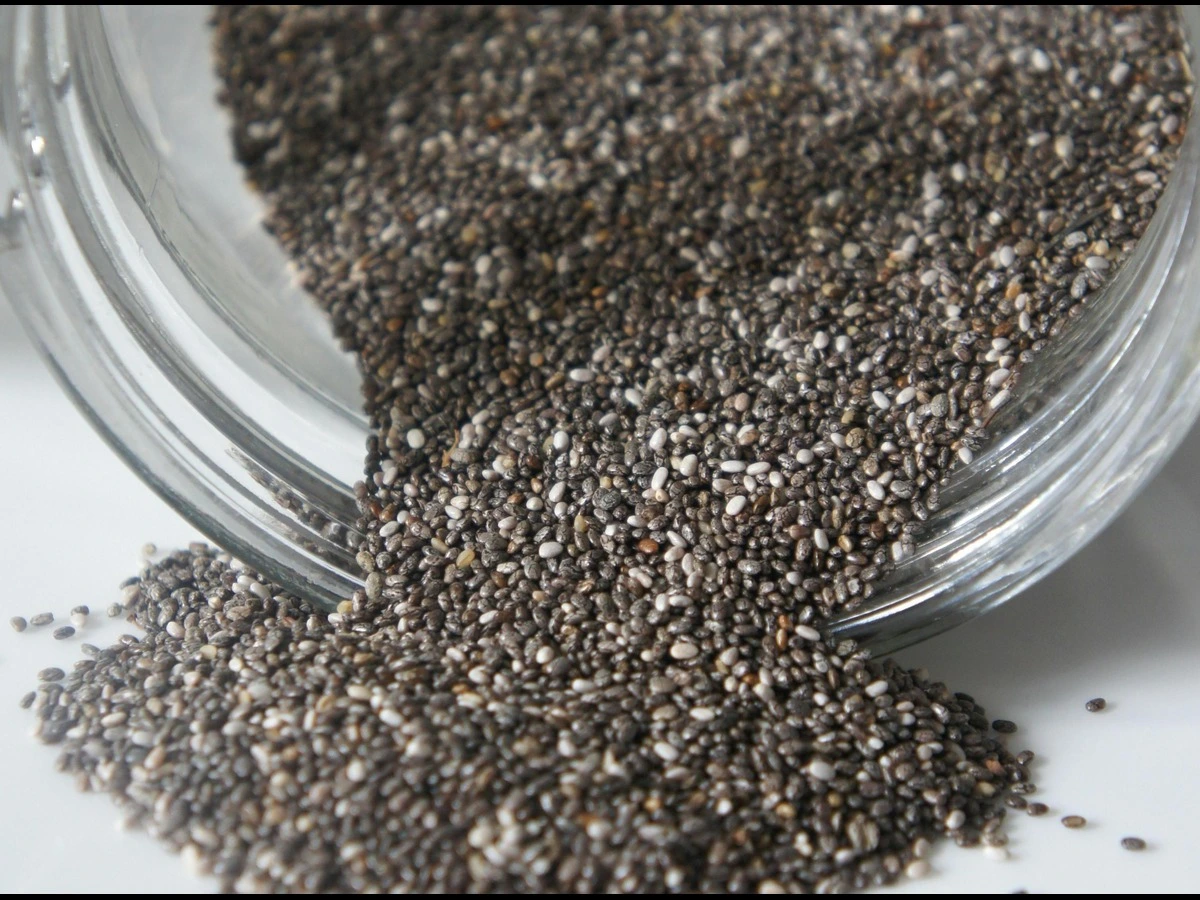Chia seeds and tukhm-e-malangha, also known as basil seeds, often look and behave so similarly that many people assume they’re the same. Both swell into a gel-like texture when soaked, both are packed with fiber, and both have made their way into smoothies, puddings, and detox drinks.
But beneath those tiny shells lies a big difference in nutrition, origin, and health effects. Let’s uncover what sets them apart and how each can benefit your health in its own way.
THE NUTRITIONAL DIFFERENCE: SAME LOOK, DIFFERENT POWER
• Although chia and tukhm-e-malangha belong to the same mint family (Lamiaceae), they come from entirely different plants. Chia seeds come from Salvia hispanica, a plant native to Mexico, while basil seeds come from Ocimum basilicum, the same basil used in cooking.
When it comes to nutrition, both are nutrient-dense, but they shine in different areas.
• Chia seeds are higher in omega-3 fatty acids, especially alpha-linolenic acid (ALA), which supports heart and brain health. They also contain more calcium and protein, making them an excellent addition for bone strength and muscle repair. On the other hand, basil seeds are lower in calories and fat but offer more fiber and magnesium, which aid digestion and hydration.
• Chia’s calorie content hovers around 480 to 490 kcal per 100 grams, while basil seeds contain roughly 230 kcal for the same amount, half the energy but equal or greater fiber content. Chia’s fats (mostly healthy omega-3s) account for much of that calorie difference.
HOW CHIA SEEDS BENEFIT THE BODY
1. Heart and Metabolic Health:
Research published in the Journal of Nutritional Biochemistry shows that the omega-3 fatty acids in chia seeds help lower inflammation, reduce triglycerides, and improve lipid profiles, factors essential for cardiovascular protection.
2. Blood Sugar Balance:
Thanks to their rich soluble fiber, chia seeds slow down carbohydrate digestion, resulting in a steadier blood sugar response. This makes them especially beneficial for people with insulin resistance or type 2 diabetes.
3. Bone Strength:
Just two tablespoons of chia provide more calcium than a glass of milk. They also supply magnesium and phosphorus, key minerals for bone mineral density, especially important for women after menopause.
4. Digestive Support:
Chia’s gel like fiber supports gut motility and nourishes healthy gut bacteria. Regular intake may ease constipation and promote long-term digestive health.
HOW TUKHM-E-MALANGHA (BASIL SEEDS) SUPPORTS WELLNESS
1. Cooling and Hydrating Effect:
Traditionally used in summer drinks like falooda or lemonade, basil seeds have a natural cooling property. When soaked, they absorb several times their weight in water, forming a soothing gel that helps maintain hydration and body temperature in hot climates.
2. Blood Sugar Regulation:
Several studies, including one published in Phytotherapy Research, indicate that basil seeds can slow the digestion of carbohydrates and reduce post-meal glucose spikes, beneficial for people managing type 2 diabetes or prediabetes.
3. Natural Appetite Control:
Because of their high mucilaginous fiber, basil seeds expand quickly in the stomach and create a feeling of fullness. This can naturally reduce appetite and calorie intake, supporting weight management goals.
4. Gut Comfort and Detox Support:
In traditional Unani and Ayurvedic medicine, tukhm-e-malangha is used to relieve acid reflux, bloating, and mild constipation. Its fiber acts as a gentle laxative while soothing the digestive tract.
THE REAL WORLD DIFFERENCES YOU ’ll NOTICE
• If you’ve ever soaked both, you’ve seen the first big clue: chia seeds take longer to swell, forming a dense, pudding-like gel in about 10 to 15 minutes. Basil seeds, in contrast, expand within minutes and form a softer, slipperier gel.
• Chia seeds have a mild, nutty taste and blend well into smoothies, yogurts, or baked goods. Basil seeds are almost tasteless, making them ideal for drinks and desserts.
• Chia offers a boost of omega-3 and calcium, while basil seeds are slightly richer in fiber and hydration benefits. One could say chia strengthens the inside, while basil seeds cool and cleanse from the outside.
WHICH ONE SHOULD YOU CHOOSE?
Both are incredibly nutritious, so your choice depends on your health goals.
• If you’re aiming to improve heart health, bone strength, and metabolic balance, chia seeds are your ally. If your focus is hydration, cooling, and digestive comfort, tukhm-e-malangha is the smarter pick.
You can even use them complementarily, chia in breakfast smoothies for sustained energy and basil seeds in an evening drink for hydration and digestion.
TAKEAWAY
Both chia and basil seeds are tiny but mighty examples of plant-based nutrition.
• Chia seeds shine as a source of omega-3 fats, calcium, and protein, promoting heart, bone, and metabolic health.
• Tukhm-e-malangha excels in fiber, hydration, and gut support, making it perfect for hot climates and weight management.
Whichever you choose, you’re giving your body a natural, nutrient-dense boost that supports overall wellness, one spoonful at a time.
FAQs
Can I eat both chia and basil seeds every day?
Yes. When consumed in moderation about one to two teaspoons soaked they’re safe and beneficial. Just ensure adequate water intake, as both are high in fiber.
Are they suitable for people with diabetes?
Absolutely. Both help stabilize blood sugar levels by slowing carbohydrate absorption.
Do they help with constipation?
Yes. Their soluble fiber softens stools and supports healthy bowel movements.
DISCLAIMER
This article is for educational purposes only and not a substitute for professional medical advice. People on blood thinners, those with swallowing difficulties, or individuals with digestive disorders should consult a healthcare provider before using chia or basil seeds regularly.
CALL TO ACTION
Add a spoonful of chia or tukhm-e-malangha to your daily routine, blend them into drinks, smoothies, or yogurt for an easy boost of fiber, omega fats, and minerals that support heart, gut, and metabolic health.
REFERENCES
1. Ullah, R., Nadeem, M., Khalique, A., et al. (2016). Nutritional and therapeutic perspectives of chia (Salvia hispanica L.): A review. Journal of Food Science and Technology, 53(4), 1750–1758.
2. Rahman, N., & Jamal, M. (2022). Evaluation of the nutritional and antioxidant potential of basil (Ocimum basilicum) seeds. Phytotherapy Research, 36(9), 3701–3711.
3. Vuksan, V., Jenkins, A. L., et al. (2017). A systematic review and meta-analysis of the effect of chia seed supplementation on cardiovascular risk factors. Nutrition, Metabolism & Cardiovascular Diseases, 27(11), 885–894.
4. Hasan, M., & Ahmed, S. (2020). Effects of basil seed consumption on postprandial glycemia and appetite in healthy adults. Food Science & Nutrition, 8(9), 4660–4668. 5. American Journal of Clinical Nutrition. (2019). The role of dietary fiber in metabolic and cardiovascular health: Evidence-based recommendations.




